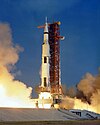| This article needs additional citations for verification. Please help improve this article by adding citations to reliable sources. Unsourced material may be challenged and removed. Find sources: "Saturn V-B" – news · newspapers · books · scholar · JSTOR (January 2023) (Learn how and when to remove this message) |
| Function | Crewed/uncrewed LEO and Lunar launch vehicle |
|---|---|
| Country of origin | United States |
| Size | |
| Height | 50 m (164 ft) |
| Diameter | 10 m (33 ft) |
| Mass | 2,313,320 kg (5,099,990 lb) |
| Stages | 1.5 |
| Capacity | |
| Payload to LEO | |
| Mass | 22,600 kg (49,800 lb) |
| Launch history | |
| Status | Concept/study |
| Launch sites | Unknown |
| Total launches | 0 |
| Booster stage – S-ID | |
| Powered by | 5 Rocketdyne F-1 |
| Maximum thrust | 30,962.50 kN (6,960,647 lbf) |
| Burn time | 154 s |
| Propellant | RP-1/LOX |
| First stage – S-ID Sustainer | |
| Powered by | 1 Rocketdyne F-1 |
| Maximum thrust | 7,740.30 kN (1,740,089 lbf) |
| Burn time | 315 s |
| Propellant | RP-1/LOX |
| [edit on Wikidata] | |
Studied in 1968 by Marshall Space Flight Center, the Saturn V-B was considered an interesting vehicle concept because it nearly represents a single-stage to orbit booster, but is actually a stage and a half booster just like the Atlas. The booster would achieve liftoff via five regular F-1 engines; four of the five engines on the Saturn V-B would be jettisoned and could be fully recoverable, with the sustainer stage on the rocket continuing the flight into orbit. The rocket could have had a good launch capability similar to that of the Space Shuttle if it was constructed, but it never flew.
Concept
With use of the Saturn V vehicle during Apollo, NASA began considering plans for a hypothesized evolutionary Saturn V family concept that spans the earth orbital payload spectrum from 50,000 to over 500,000 lbs. The "B" derivative of the Saturn V was a stage and one- half version of the then current S-IC stage and would become the first stage in an effective and economical assembly of upper stages of the evolutionary Saturn family.
The booster would achieve liftoff via five regular F-1 engines; four of the five engines on the Saturn V-B would be jettisoned and could be fully recoverable, with the sustainer stage on the rocket continuing the flight into orbit. The vehicle would be capable of a LEO payload of 50,000 lb with a standard S-IC stage length of 138 ft. Increases in the length of the stage could significantly increase this capability.
See also
References
- ^ Scott and, Ronald D.; Corcoran, William L. (1968). "Saturn V Derivatives". SAE Transactions. 77. SAE International: 1099–1112. JSTOR 44565202. Retrieved January 7, 2023.
Further reading
- Saturn V-B refers to Boeing study
| Saturn launch vehicle family | ||
|---|---|---|
| Early proposals |  | |
| "C" series | ||
| Saturn I series | ||
| Saturn II series | ||
| Saturn V series | ||
This rocketry article is a stub. You can help Misplaced Pages by expanding it. |